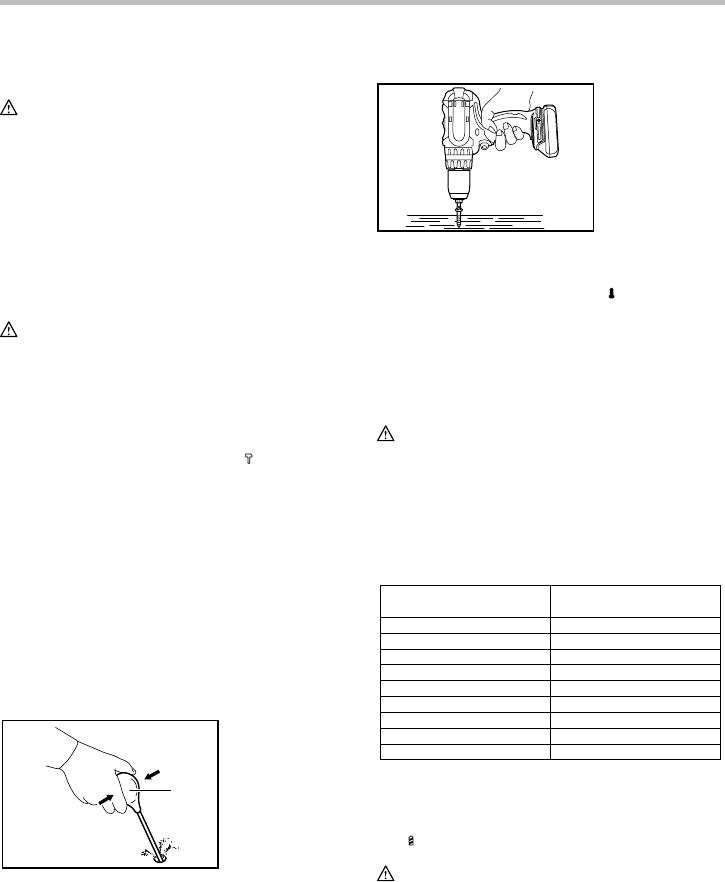
7
OPERATION
CAUTION:
• Always insert the battery cartridge all the way until
it locks in place. If you can see the red part on the
upper side of the button, it is not locked completely.
Insert it fully until the red part cannot be seen. If not,
it may accidentally fall out of the tool, causing injury
to you or someone around you.
Hold the tool firmly with one hand on the grip and the
other hand on the bottom of the battery cartridge to
control the twisting action.
Hammer drilling operation
CAUTION:
• There is a tremendous and sudden twisting force
exerted on the tool/bit at the time of hole
break-through, when the hole becomes clogged
with chips and particles, or when striking
reinforcing rods embedded in the concrete.
First, turn the action mode changing ring so that the
arrow on the tool body points to the
marking. The
adjusting ring can be aligned in any torque levels for this
operation.
Be sure to use a tungsten-carbide tipped bit.
Position the bit at the desired location for the hole, then
pull the switch trigger. Do not force the tool. Light
pressure gives best results. Keep the tool in position and
prevent it from slipping away from the hole.
Do not apply more pressure when the hole becomes
clogged with chips or particles. Instead, run the tool at
an idle, then remove the bit partially from the hole. By
repeating this several times, the hole will be cleaned out
and normal drilling may be resumed.
Blow-out bulb (optional accessory)
1
002449
After drilling the hole, use the blow-out bulb to clean the
dust out of the hole.
Screwdriving operation
008356
First, turn the action mode changing ring so that the
arrow on the tool body points to the
marking. Adjust
the adjusting ring to the proper torque level for your work.
Then proceed as follows.
Place the point of the driver bit in the screw head and
apply pressure to the tool. Start the tool slowly and then
increase the speed gradually. Release the switch trigger
as soon as the clutch cuts in.
CAUTION:
• Make sure that the driver bit is inserted straight in
the screw head, or the screw and/or bit may be
damaged.
NOTE:
• When driving wood screws, predrill pilot holes to
make driving easier and to prevent splitting of the
workpiece. See the chart.
Nominal diameter of wood screw
(mm)
Recommended size of pilot hole
(mm)
3.1 (1/8") 2.0 - 2.2 (5/64" - 3/32")
3.5 (9/64") 2.2 - 2.5 (3/32" - 3/32")
3.8 (5/32") 2.5 - 2.8 (3/32" - 7/64")
4.5 (11/64") 2.9 - 3.2 (7/64" - 1/8")
4.8 (3/16") 3.1 - 3.4 (1/8" - 9/64")
5.1 (13/64") 3.3 - 3.6 (1/8" - 9/64")
5.5 (7/32") 3.7 - 3.9 (9/64" - 5/32")
5.8 (7/32") 4.0 - 4.2 (5/32" - 11/64")
6.1 (15/64") 4.2 - 4.4 (11/64" - 11/64")
006576
Drilling operation
First, turn the adjusting ring so that the pointer points to
the
marking. Then proceed as follows.
CAUTION:
• Pressing excessively on the tool will not speed up
the drilling. In fact, this excessive pressure will only
serve to damage the tip of your bit, decrease the
tool performance and shorten the service life of the
tool.
• There is a tremendous force exerted on the tool/bit
at the time of hole break through. Hold the tool
firmly and exert care when the bit begins to break
through the workpiece.
1. Blow-out bulb


















